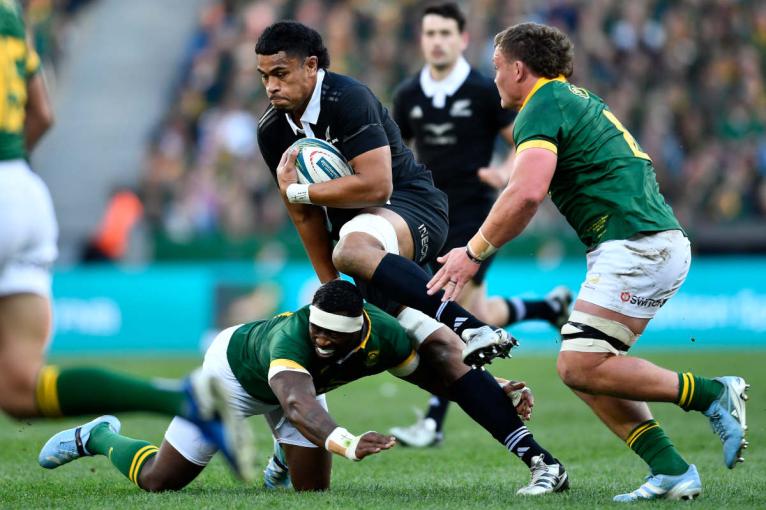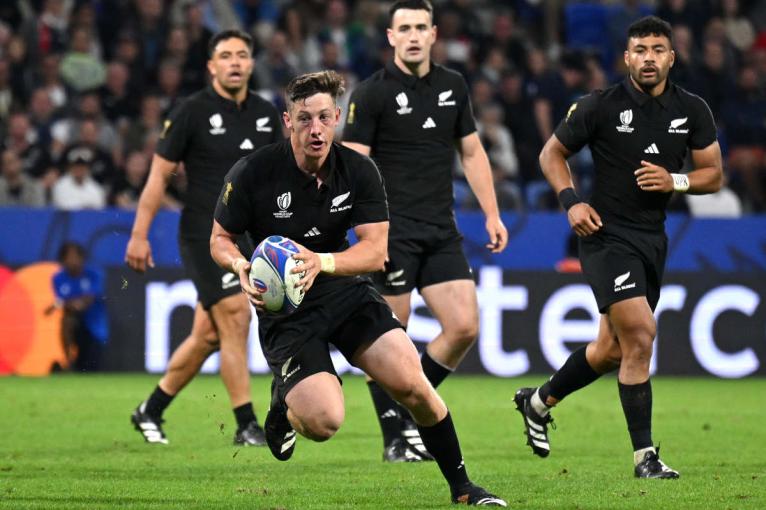It has been a bumpy season for the All Blacks, one seemingly filled exclusively with erratic performances that have led to modest results. The record of five wins from eight Tests is so-so, but the bigger concern for the media and public alike has been the lack of emphatic performances.
There was a memorably good 40-minute blitz to blow Argentina away at Eden Park, and in the first 20 minutes against Australia in Sydney, the All Blacks scored three tries in 16 minutes and were threatening to run up the sort of scoreline that would have left the Wallabies humiliated.
But in both those games, the All Blacks lost their way in the second half, just as they did in their two Tests against South Africa, and to some extent, when they played England in July.
For a team that has built its reputation on being ruthless, merciless even, these eight performances to date in 2024 have left a nation feeling underwhelmed.
The angst is understandable – New Zealanders are used to not only seeing the All Blacks win, but mostly doing so with high-intensity, high-skill performances.
But this angst is perhaps preventing everyone from seeing that the foundations of a good World Cup 2027 team are being laid.
In the last month or so, a handful of young, potential superstars have emerged – players who by 2027, may be best in the world in their respective positions.
The All Blacks have won only five of their eight Tests this year but have brought through a raft of youngsters (Photo SAEED KHAN/Getty Images)
It’s not all doom and gloom, therefore, but it may be hard for the All Blacks coaching group to sell the public a narrative of rebuilding and success lying in the future and not the present.
Building the next generation has always been a tricky business for All Blacks coaches, because they are under intense and consistent pressure to maintain a winning record, and have no licence from either the public or their employer to lose today to enable them to win tomorrow.
The deal for All Blacks coaches is win today and win tomorrow, which is a philosophy that they alone follow, and one that can be seen by comparing their record in the last two World Cup cycles with the Springboks.
Between 2016 and 2019 (not including the World Cup), the All Blacks won 87 per cent of their Tests; and between 2020 and 2023 (not including the World Cup) they won 68 per cent of their Tests.
The 68 per cent win ratio in the last cycle was bad enough to see then coach Ian Foster almost fired, and so the All Blacks don’t have the luxury of building a team to mature over four years to win the World Cup the way the Springboks seemingly do.
The Springboks between 2016 and 2019 (not including the World Cup) won 49 per cent of their Tests; and between 2021 (they didn’t play in 2020 due to Covid) and 2023 (not including the World Cup), they won 65 per cent of their Tests.
The Springboks won both the 2019 and 2023 World Cups, but their success ratio in between tournaments would never have washed with the New Zealand public had it been the All Blacks producing those numbers.
The 68 per cent win ratio in the last cycle was bad enough to see then coach Ian Foster almost fired, and so the All Blacks don’t have the luxury of building a team to mature over four years to win the World Cup the way the Springboks seemingly do.
This try was perfection #AllBlacks #SAPBestRun pic.twitter.com/2FPGrbbrXy
— All Blacks (@AllBlacks) September 23, 2024
New Zealand wouldn’t put up with a 50 per cent win ratio in a World Cup cycle even if they were crowned world champions at the end of it and the challenge for head coach Scott Robertson is to lift his current 62 per cent success rate and yet keep building a team that will peak in 2027.
And there are clear signs that he’s got the basis of a team that can do the latter as the big improvers and stars of the show in 2024 have been young men such as Tupou Vaa’i, Wallace Sititi, Cortez Ratima, Caleb Clarke and Tamaiti Williams – all of whom are 25 or younger.
Vai’i, who was first capped in 2020, can’t exactly be called a find, but he’s advanced incredibly this year as a result of winning regular game time due to the retirements of Sam Whitelock and Brodie Retallick.
Prior to this year, Vai’i had done little to suggest he’d be so prominent and influential if given the chance, but he’s suddenly found the ability to clear big men out of rucks, become a disruptive lineout operator, carry with punch, get around the park and tackle well.
Tupou is right up there with the world’s best. And it’s a real credit to him. He’s becoming a man, I guess. And you know, his future is all still in front of him, that’s for sure.
Jason Ryan
He’s arguably outshone captain Scott Barrett as the best lock on view and at 24, there is some excitement building as to how good he might be in 2027.
Forwards coach Jason Ryan, not prone to talking any young forwards up, broke that habit when he was asked to assess Vai’i’s season ahead of the first Bledisloe clash.
“I think he’s probably been one of the in-form All Black forwards, in his area, in this test season.
“It’s a continuation, he had great form for the Chiefs. And he’s well established in the Test arena now.
“And he’s right up there with the world’s best. And it’s a real credit to him. He’s becoming a man, I guess. And you know, his future is all still in front of him, that’s for sure.”
 Tupou Vaa’i has stood up in 2024 and is maturing into a Test match lock in the wake of Sam Whitelock and Brodie Retallick retiring (Photo Ashley Vlotman/Getty Images)
Tupou Vaa’i has stood up in 2024 and is maturing into a Test match lock in the wake of Sam Whitelock and Brodie Retallick retiring (Photo Ashley Vlotman/Getty Images)
Wallace Sititi is another young forward overachieving, having shown he can handle the physical demands of Test rugby.
The 22-year-old has been powerful on both sides of the ball, and while he may not be the answer at blindside, there’s a strong argument based on the impact he made against South Africa and Australia, that next year he should shift to his preferred No 8 role and Ardie Savea return to his original home at openside.
Part of the attraction of shifting Sititi to No 8, is that it would enable him to continue to develop his Chiefs combination with scrum-half Cortez Ratima, who has arguably been the find of the season for the All Blacks.
The 23-year-old No 9 has brought pace to the All Blacks’ attack, and has been an effective runner, too, cutting open Australia a couple of times in Sydney, in a performance that was innovative and accurate, and arguably Sititi and Ratima were vying to be considered man of the match in Bledisloe One.
It is beyond doubt, now, that Ratima and Cam Roigard – the 23-year-old Hurricanes No 9 who is close to coming back after serious injury – are going to be the All Blacks match day halfbacks for much of this World Cup cycle.
Asked about their performances, and seasons so far, Robertson said: “[I’m], just pleased that they [have]got the courage to show their talent and their skill set on the bigger stage.
“So early in their Test career, they step right to the occasion, don’t they, in the big moments. And, you know, it’s great when you give a young guy, young players opportunities and they take them.
“And, you know, the last three weeks, both of them have been remarkable. Great story, isn’t it?”
It is beyond doubt, now, that Ratima and Cam Roigard – the 23-year-old Hurricanes No 9 who is close to coming back after serious injury – are going to be the All Blacks match day halfbacks for much of this World Cup cycle.
 Cam Roigard is out injured but along with Cortez Ratima, will likely form the 2027 half-backs for the All Blacks (Photo by Hannah Peters/Getty Images)
Cam Roigard is out injured but along with Cortez Ratima, will likely form the 2027 half-backs for the All Blacks (Photo by Hannah Peters/Getty Images)
Clarke is the other youngster who is punching above his weight in 2024. He’s been in and out of the team since making his debut in 2020, but finally, now that he’s injury free and fully fit, the All Blacks are seeing the best of him.
He’s back to being an unstoppable runner, but the real benefit he’s brought is his aerial skills and ability to win back contestable kicks.
It’s a rare mix of size, speed, power and soft skills and if he can avoid injuries, he’ll be the All Blacks preferred left wing for the remainder of the cycle.
Throw in the form of 24-year-old loosehead prop Tamaiti Williams, and it becomes apparent that the All Blacks have already found the core of their team for 2027.
This new group are emerging alongside Tyrel Lomax, Ethan de Groot, Fletcher Newell, Scott Barrett, Jordie Barrett, Rieko Ioane and Will Jordan, who are all established All Blacks with the age profile to be at peak form come 2027.
Ardie Savea, who turns 31 next month is a strong probability to still be in world leading form come 2027 and the only question marks that the All Blacks have now is whether 33-year-old hooker Codie Taylor and 33-year-old utility back Beauden Barrett can make it that far.
But there is this whole issue of how patient the public can be if the results continue to sit at around the 60 per cent mark.
The All Blacks have never previously tolerated that low a win ratio from any coach and so while Robertson may well be building something special for 2027, he’s going to have to win more tests than he currently is to keep the public from venting and the pressure from mounting.
Copyright for syndicated content belongs to the linked Source link
The post How the All Blacks are enduring pain now in readiness for 2027 RWC crusade first appeared on Rugby 247.
—-
Author : rugby-247
Publish date : 2024-09-26 11:54:47
Copyright for syndicated content belongs to the linked Source.